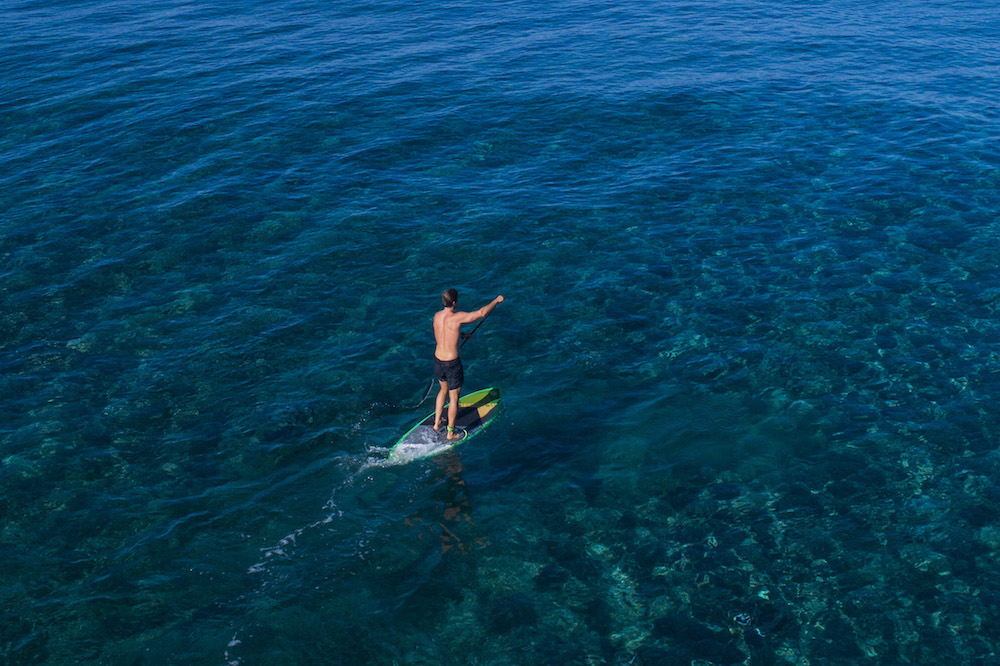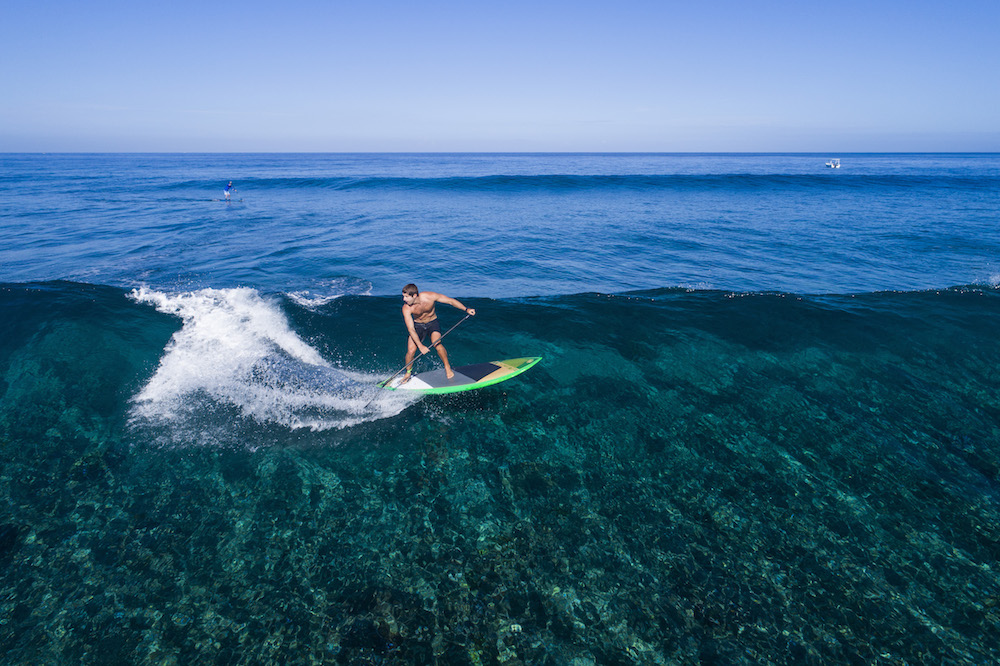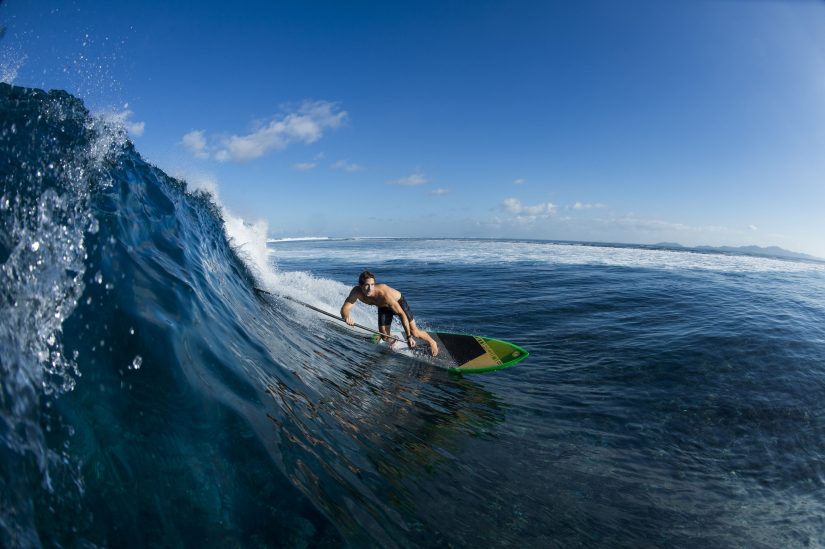PADDLE TECHNIQUE, STANCE AND GETTING STARTED
Article by Rory Chapman.
I first discovered stand up paddling on Namotu Island in 2012 when I was working there as a lifeguard. I caught my first wave on a 10ft SUP board and instantly realised it offered another way to spend more time in the ocean. I was hooked and have since taught on Dave Kalama’s Namotu camps and of course on Ben Wilson’s Kite Weeks.
I’ve also enjoyed the competition side of SUP, entering in races such as the Molokai 2 Oahu, Paddle Board World Champs and the Sunset Beach Pro. Stand up paddle has opened up lots of doors for me, but at the end of the day it’s just another way to catch waves.
Although Namotu Island is one of the more user-friendly places to learn to surf, kite or stand up paddle, with a few pointers you can learn almost anywhere.
WHERE TO BEGIN
Stand up paddling can be done on practically any body of water but before getting out there you should always have some understanding of the current conditions. Always be aware of the local tide, winds, any rules and regulations, and hazards. If you’re already comfortable paddling on flat water and want to get into the waves, start with small running waves and work up from there. Even if you’re a confident surfer or wave kiter it’s good to start out with small, gentle waves.
Whenever you’re sharing waves with others it’s important you understand surf etiquette. Standard surfing right of way applies – the person closest to the breaking section of the wave has right of way however you can’t just drop in behind someone already on the wave and expect them to hand the wave to you. It’s also good to remember that on a SUP you’ll can catch waves a lot further out than most other surfers so be aware of this and share waves with the other riders. SUPers have earned a really bad reputation because so many overlook that.
Always do your best to surf waves that match your ability. Armed with a big board and a paddle you can quickly become very dangerous to yourself and others around you. Remember, your board might be 9ft long but you also have an 8-9ft leg rope so if you lose your board it can end up causing damage to people and their equipment from quite a distance.
EQUIPMENT
Your first board should be large and stable. Most people starting out need something between 8-10ft, and depending on your weight, a board with over 100 litres of volume.
Next you’ll need a paddle. I think an adjustable carbon paddle is the go; they’re better for travelling and allow you to change the height to suit flat water, waves or a friend! *Remember to hold paddle with the blade pointing forward, not back.
You’ll also need a leg rope. You can choose one that attaches to your knee or ankle depending on your personal preference.
Although not essential, some people feel more comfortable wearing a life jacket and there are some great ones designed for surf on the market!
There are many brands out there offering a lot of different models with a range of price tags to match. Remember like most sports, once you become more skilled you’ll want to start experimenting with equipment so don’t get too worried about the bells and whistles on your first board. Just look for a safe, strong and stable board with a lightweight yet strong paddle and the necessary safety equipment.
BOARD & BODY POSITIONING
When paddling, it’s best to stand with your feet inline and pointing forward at about shoulder width apart on your board. Even if you’re attempting to catch waves it’s best to begin in the basic paddle position. Then once you have momentum and are about to drop into the wave, shift your feet into a surf stance without looking down just keep your eyes and head focusing where you want to go. Keep your paddle still in your hands with the blade facing back. Once on a wave it’s possible to use your paddle for balance, turning and to feel the wave.


PADDLE TECHNIQUE
Paddling technique is broken down into three stages.
- REACH.
Paddle in hands as shown, knees slightly bent and back straight. Use your hips as a pivot point, keeping your back straight throughout the motion. As you begin to lean forward from the hips, reach forward with your arms and paddle, sliding the blade into the water as far up the front of the board as possible for an efficient stroke.
- PULL.
Now use your core muscles and while still holding and pulling your paddle through the water, bring your body back to a neutral position. Once you have pulled the paddle inline with your feet you have finished the pull stroke and can bring the paddle up out of the water and move through the rest stage.
- REST.
In this stage, bring the paddle from the end of the stroke back to the reach stage. This is your time to take a breath and prepare for the next stroke.
CATCHING & RIDING WAVES
The takeoff area for SUP is similar to surfing but tends to be further out, before it has capped. Paddle with the wave heading in the same direction it’s moving while in your paddling stance then as you drop into the wave, switch to your surf stance and attempt to ride the power zone or pocket of the wave as a regular surfer would, maintaining a position just in front of the foam. Watch the video to see the whole process.
WHO SHOULD TRY SUP?
SUP is great for developing core strength and is a good alternative to surfing for people with knee or spine injuries that prevent popping up or laying on a board paddling. Developing this strength does take time so stick with it and you’ll tone and strengthen your whole body while having fun in the water. Your local watersports store is usually a great place for advice but if you have any questions for me, you can reach me via Facebook.
When paddling, it’s best to stand with your feet inline and pointing forward at about shoulder width apart on your board. Even if you’re attempting to catch waves it’s best to begin in the basic paddle position. Then once you have momentum and are about to drop into the wave, shift your feet into a surf stance without looking down just keep your eyes and head focusing where you want to go. Keep your paddle still in your hands with the blade facing back. Once on a wave it’s possible to use your paddle for balance, turning and to feel the wave.

